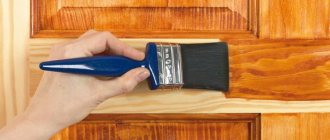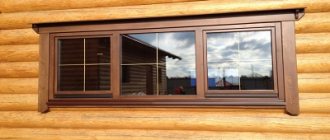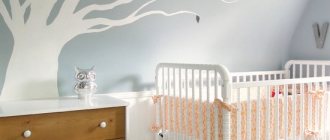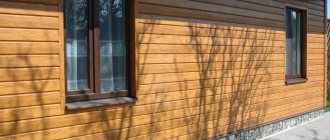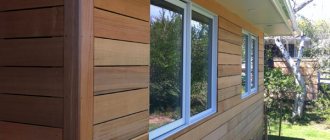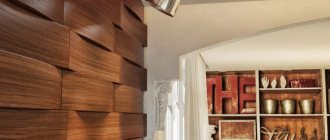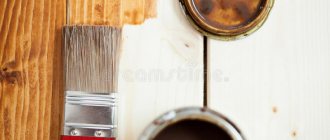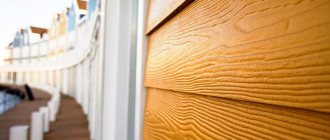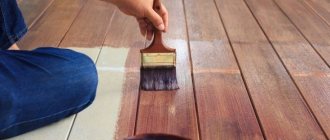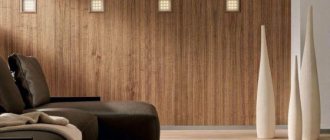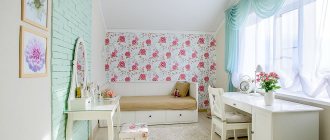The possibilities of using wood in the interior are endless
Wood in the interior is a simple and environmentally friendly way to transform any room. In the 21st century, most people live in panel, brick or block houses. However, many of them continue to be drawn to materials such as stone and wood. Appropriate decorative elements will help you get out of the situation.
Features of wood material
Wood is one of the most ancient building materials, the features of which include:
- ease;
- strength;
- density
- versatility of use;
- environmental cleanliness;
- high porosity;
- low thermal conductivity;
- decorativeness;
- good internal air exchange;
- high chemical resistance;
- ability to resist dynamic and static loads well.
Design project: Dmitry and Daria Grigoriev, Alina Ursova
Wooden materials are easy to glue, lend themselves well to machining and firmly hold various metal fasteners.
Application
As a rule, natural wood is chosen for two reasons:
- It is necessary to use only natural, environmentally friendly material, and wood is the best option. In such cases, the surfaces can be painted and processed in any way; here the origin is primary, not the texture.
- What is needed is a specific texture, pattern, shade - and it is according to these parameters that the material is selected. It can be modified if necessary, but the authentic nature of the material must be visible.
Both approaches are actively used, with the first becoming increasingly popular now. Many people choose wood precisely because it is the safest from an environmental point of view. And this desire to ease the burden on the ecosystem is very significant - people are acting consciously, they are beginning to understand that they need to do everything possible to the best of their ability to minimize the harm caused to the planet.
Pros and cons of wood in the interior
Pros:
- fits organically into any environment;
- makes the room more comfortable;
- keeps warm;
- easy to clean;
- absorbs sounds;
- emits a pleasant aroma;
- has sufficient strength, durability and beautiful appearance;
- can be easily painted, polished, or varnished;
- normalizes the process of moisture exchange and creates a healthy microclimate in the house;
- does not emit harmful substances;
- “revitalizes” the interior, gives it naturalness;
- goes well with other materials (stone, leather, brick, fabric, glass, ceramics, metal and others);
- provides ample opportunities for realizing design imagination.
Minuses:
- rapid flammability;
- the possibility of bugs appearing;
- tendency to swelling and warping due to increased hygroscopicity;
- the possibility of rotting due to changes in ambient humidity;
- heterogeneity of structure.
The main disadvantage of using wooden finishing indoors is the natural material’s tendency to absorb moisture and rot.
The choice of moisture-resistant species and treatment with special means help to cope with this, thanks to which the wood can be used in the kitchen and even in the bathroom.
Spili
A potentially extremely rich artistic element is the end cut of a round timber. These dies of different diameters, mounted on a wall or partition, create a magnificent decorative effect.
The saw cuts imitate a woodpile well, which fits perfectly into the interior of a kitchen or living room with a fireplace. In this case, in addition to round ones, it is advisable to also use semicircular and quarter dies. This will tighten the fit of the cuts to each other, reduce voids and give an even greater resemblance to a woodpile.
A separate category is cuttings of large diameter trunks. As a rule, they are used in the manufacture of countertops and wall panels of non-standard type. Very thick unedged boards can also be used as tabletops.
A stump can be considered a special case of sawing. It can also be used as a stand under a tabletop, preferably a glass one, so that all the smoothness and whimsicality of the lines of a tree trunk can be seen, and also as a coffee table itself, or a bedside table, if the diameter allows.
Wood in the living room interior
To make the living room look cozy and at the same time respectable, you can add windows, doors, parquet, solid or deck boards and fireplace surrounds to wooden furniture.
For furniture upholstery, it is preferable to choose high-quality natural materials.
Particular originality will be given to the interior of the living room by covering the wall with wooden slabs of different shapes and sizes, located in three planes, parallel to the wall, and partially overlapping each other.
The noticeably expressed texture of the wood is emphasized by the lamps built into the lower ends of the slabs. This environment looks expensive and luxurious.
The space behind the sofa will not look empty if you fill it with an openwork partition made of slats and bars. A small table made from untreated boards can be a nice decoration for the living room.
Light and airy Scandinavian style involves decoration and furniture made of light wood.
For rooms decorated in Provence or minimalist style, light wood species (beech, birch, pine, alder) are also suitable.
For classics, it is preferable to use dark wood (red, walnut, wenge).
Design project: Bellas Artes
Interior design rules
If you decide to decorate the interior yourself, including various wooden coverings, you need to adhere to the basic rules:
- Three shades. Excessive use of wood in decoration can lead to negative consequences. It is better not to combine more than three wood tones in one room, otherwise the decor will lose its harmony. The combination of mismatched sets and products with completely incompatible textures looks especially unattractive.
- Accents. Materials of contrasting shades can look good in one interior. Also attractive will be a modest setting, diluted with “wood accents” - unusual parquet, ceiling beams, panels, non-standard furniture.
- Single range. No less delicate and stylish in appearance is the room, in which several components are decorated in similar shades of natural wood. This design is neutral in perception and does not have a negative impact on mood. However, all colors should be independent, and not differ by just half a tone.
- Lighting. The quality and quantity of light in a room is of direct importance for the correct assessment of a particular shade. If the room is located on the north side and there is little natural light in it, you should abandon non-contrast combinations. The transition between similar shades will be simply unnoticeable. Warm wood tones look more interesting with yellowish lamps.
Wood in the bedroom interior
Wood in the interior is also used for finishing walls, floors and ceilings, which is perfect for a bedroom.
And elegant carved wooden furniture means not only a beautiful design, but also a healthy sleep surrounded by safe and environmentally friendly material.
Light wood, shaded with bright accents, will create an atmosphere of peace and comfort.
For painting, choose milky, pistachio, beige or mustard shades. The matte finish looks more natural, but varnishing visually expands the space.
When using wood in the bedroom interior, you should not give preference to massive furniture, so as not to overload the room.
Design project: Sergeeva Anna
Curtains and textiles made from natural materials (wool, cloth, linen) will be an excellent addition to the interior.
The wall behind the head of the bed covered with wood panels or clapboard will provide excellent sound and heat insulation.
Wood wall decoration
Wood finishing is one of the latest trends in interior design. You can decorate the walls with boards or lining (thin cladding boards). This design looks very expensive, which is true. But with the right investment (choosing a quality type of wood, pre-processing it, etc.) you will save significantly in the future, when you can avoid repairs for years.
For finishing it is best to choose natural wood. The most popular premium wood species are oak, walnut, ash and teak.
To save money, you can do partial wood finishing. It looks no less impressive and requires much less effort.
Wood in the kitchen interior
In spacious rooms with large windows, sets made of dark wood look good, and for a small space, light furniture, complemented by glass details or mirror inserts, is better suited.
Contrasting wooden countertops and a parquet floor expressively fit into the kitchen interior with plain light walls, ceiling and furniture.
A table made from solid processed logs, surrounded by stylish modern furniture, will add sophistication to the kitchen environment.
A wooden ceiling in combination with wood wall trim and accessories will make the kitchen feel cozy and warm in a rustic way.
Beam-shaped ceilings are a good solution for decorating a room in a rustic or country style.
Wallpaper
Few people know, but the modern market offers nature lovers... wooden wallpaper! They can be made from:
- natural wood;
- traffic jams;
- veneer
Bedroom with veneer wallpaper
Thanks to its aesthetic properties, wood easily fits into any room
Such wallpapers are panels consisting of small boards. All elements are easily joined together, which allows you to preserve the natural pattern. It is characteristic that wooden wallpaper does not require any special preparation of the walls: the finishing should be standard. You can assemble such a wall with your own hands, and in the shortest possible time. However, it should be remembered that such wallpapers are afraid of moisture, as well as insect pests. Therefore, finishing walls with wood will require special care.
Wooden wallpaper is a fairly new and attractive way to decorate walls in a room.
Wood in the bathroom interior
Thanks to antiseptic impregnations, wooden furniture, wall and floor decoration can be used to stylishly decorate a bathroom.
To furnish rooms with high humidity, moisture-resistant tree species that are resistant to the formation of mold and other fungi are used.
From such materials you can make any piece of furniture, right down to the bathtub or sink.
To furnish bathrooms, they usually use materials treated with special means: edged boards made from valuable trees, block houses and imitation timber.
Wood is a traditional material
Wood is primarily associated with flooring and furniture, but it used to be the traditional building material for constructing entire houses. Russian huts, English, Finnish and Swedish houses, Swiss chalets were not built without the use of wood. However, this tradition is already becoming more and more in demand and appreciated.
Thanks to professional design work, the combination of even outdated wood with elegant lamps and fashionable furniture will not cause misunderstandings or discomfort for visual perception.
The tradition of wooden house building today has grown into professional construction of wooden houses. The “natural” interior is increasingly fascinating, attracting with the unique opportunity to combine utility with style, originality and luxury. This natural and comfortable material allows you to create all kinds of style solutions - from Japanese to high-tech wood.
Wood accents
Instead of cluttering the room with wood trim, you can simply add wood accents that will make the room more cozy and interesting.
Wooden windows and doors
High-quality window frames and slopes made of environmentally friendly material are a more preferable option than metal-plastic ones.
In combination with wooden doors that match the color, they will give the room solidity, expressiveness and originality.
The most suitable types of wood for door production are merbau, beech, birch, oak and cherry.
Wooden furniture
The choice of options for upholstered and cabinet furniture made of wood depends on the taste and preferences of the owners.
For example:
- High-quality tables, sofas, chairs, armchairs, cabinets, chests of drawers and beds are made from valuable species, combining wood with velor, leather and other materials.
- Objects typical of peasant huts are given a dilapidated appearance by bleaching.
- Furniture made from wood with natural cracks and knots is especially popular.
- To create designer furniture with a medieval feel, antique door locks and hinges, as well as old boards, are used.
- The furnishings in the Scandinavian style are made up of simple-shaped furniture, most often rectangular, complemented by elements made of hides, cotton, linen, ropes, wicker rope, and wood for the fireplace.
- A trend among the world's leading designers is furniture cut from solid trunks, on which knots and cracks stand out noticeably.
Wooden columns and partitions
To delimit the space in the room, decorative partitions are installed, solid or shelved, using wooden beams, edged boards and clapboard, which is used to cover the frame.
A lattice partition decorated with indoor plants is a good way to liven things up.
Wooden ceiling and walls
Wood-covered walls, floors and ceilings are appropriate in high rooms with large windows, and the amount of furniture should be minimal, for example: a soft corner, a small table and a light-colored carpet.
In rooms with high ceilings, design elements such as ceiling beams and columns are often used to create a special atmosphere.
The ceiling, decorated with wooden details imitating ceiling beams, goes well with both loft-style design and Japanese, English, Provence or country.
Design project: Indre Dorofeendu
Which finish to choose for a wooden style
The variations in the use of this interior decoration are endless. You can use special prepared material, unprocessed or protected. The finish can be not only light or dark brown.
The panels can cover the entire wall or one wall, and can be used as decorative inserts near window sills, a TV, or a bed.
The finish can be selected in various colors:
- Red wood. Suitable for creating a strict and rich style. Very compatible with brick or stone. If you dilute the wood with textured wallpaper, it will add coziness to the room.
- White fills the room with light and adds nobility. In this case, the emphasis can be placed on furniture.
- Gray wood is rare but adds a monochromatic touch to the design. As you know, gray color is calming, so you can safely decorate your sleeping area with gray walls made of wood.
Wood can be not only brown and beige, but also other colors.
Wooden decor from branches, stumps and saw cuts
Original decorations will decorate and refresh the interior:
- A large luxurious branch with lighting, placed in the form of a panel on a plain wall and contrasting with it in color.
- Decorative hangers, vases and lamps made from branches of original and unusual shape.
- Chairs and tables, for the manufacture of which old stumps of a suitable size with previously removed bark are used. Such items look especially impressive next to leather-covered furniture.
- Stumps are used to make original coasters for glass tabletops.
- Sanded and varnished longitudinal cuts are a natural material from which shelves, table tops, and headboards are made.
- Round end cuts can also become a material for an original tabletop or an imitation of a woodpile if they are placed on a wall in the kitchen, office or fireplace area.
- A trend in modern furniture production has become small dressing tables made from saw cuts, which will fit perfectly into any interior.
Decor made from branches and even whole trees is ideal for a room with large stained glass windows, furnished with light furniture with chrome details.
Can be found under your feet
Much of what can be successfully used for the interior can be found in the forest or even on the street. We have already talked about how saw cuts can be used; but this is not all that can be “borrowed” from nature.
- Stump. This “good” can be found both in the forest belt and on the plot. By subjecting it to minimal processing (grinding and varnishing), you can get a table, bedside table, lamp stand or chair. The natural pattern characteristic of wood will highlight your taste. However, if you want to achieve a completely different effect, the stump can be coated with paint and even... gilding. This will give the interior a special sophistication. And you can achieve this effect with your own hands.
Huge tree stump as a coffee table
Gilded stumps in an art deco interior
- Branches and brushwood. To understand how to use them in the interior, it is better to familiarize yourself with the numerous photos published on the World Wide Web. So, you can find a photo of a table made in the form of an armful of branches, intercepted with twine in several places. You can place transparent glass on top of an unusual design: this way minimalism will intertwine with mysticism.
Beautiful bedroom design
Small tables made in the form of armfuls of branches
Advice! Do you want to give your children's room some originality, but do it with little money? Easily! All you have to do is find a large tree branch and paint it in bright colors. Then you need to secure it to the wall as securely as possible. If the side branches are strong enough, you can hang small toys or colorful patches on them. The child will be delighted with such a bright detail, and most importantly, he will be able to help create it with his own hands. In this case, the wallpaper in the room should be plain.
Tree branch in the wonderful interior of a children's room
A branch decorated with paper birds will add personality to a child's room.
- Driftwood. Often in nature you can find driftwood that resembles various shapes. They can also be used in the interior of an apartment.
Driftwood sink stand
Advice! You can do the same if you accidentally come across a stone of an interesting shape and shade. By combining it with an interesting wooden element or other natural materials, you can create a unique composition with your own hands.
Combination of wood with stone and brick
In rooms with walls made of natural stone or brick, or covered with stone-like materials, partitions made of wood look great.
This combination looks respectable and harmonious, especially for eco, Provence and country styles.
Stone and brick in the design of the room are ideal for the industrial style.
Country or loft is a good addition to wooden ceiling beams and columns.
It is appropriate to use this design in large country houses with high ceilings, for which reducing space is not a problem.
Plank flooring harmonizes perfectly with pebble mosaics, and wood trim and furniture in the bathroom combined with a stone floor will give the room the appearance of a sauna.
Masonry made of plain, different-sized, whitened or aged bricks is ideally combined with a wooden staircase.
When using wood and stone in design, you need to follow the principle of alternation:
- smooth with rough;
- cold with warm;
- dark with light.
Common types of wood for furniture
The most common option is pine. This tree has a light yellow or yellowish-red color. This material is not a very hard wood, but it attracts furniture makers with ease of processing, and the manufactured furniture is characterized by sufficient durability and strength.
Trees that grow in northern latitudes are of especially good quality. They are straight, have a good length and are distinguished by straight layers, which is also valued when performing construction work.
The advantages of pine also include price. In addition, it is a strong and light wood, it responds well to woodworking tools, holds glue and other impregnations well, and many people like its color. Pine usually serves as a material for inexpensive furniture, as well as doors, window frames and others, which are widely used in construction and for interior decoration.
Walnut is one of the most popular wood colors used in interiors. Furniture made from this wood is ideal if you prefer style, elegant classics, or modern. It harmonizes well with interiors in the tones of the autumn palette. Photos of furniture made from this rich material clearly show that these furnishings give the room a special completeness.
Furniture made from larch has many advantages. This material is considered to be the best in terms of carpentry and construction processes. Larch is a wood with a reddish tint, characterized by excellent strength combined with light weight. This species is much more stable and stronger than oak and beech. A tree whose color is special and very popular is larch. And its resistance to air and water is explained by the high content of resin in the wood. This wood is easy to process, which allows you to get a very high-quality and smooth-looking material. Products made from larch are not afraid of wormholes, and they practically do not warp.
Oak has hard and strong wood, the color of the wood is yellow-brown with pronounced annual layers. A variety of products, as well as floor and wall coverings made from this type of wood are in demand, almost evidence of the high status of the owner who uses this material to furnish the premises. Young oak wood is a flexible, hard material with an elegant grayish-brown color. But the old tree is distinguished by brittle and more yellow wood. When choosing this material, measures should be taken to prevent wormholes.
Let's take a closer look at the most used colors for furniture.
Selection of finishing material
In addition to natural wood, materials that imitate wood are also used for interior decoration.
MDF and chipboards
Formed from compressed wood waste.
This is an environmentally friendly material that, with the right lighting, looks just like real wood.
Chipboard is made by grinding illicit wood and further mixing sawdust with formaldehyde resins.
Laminated boards are used in furniture production and for interior decoration.
Laminate
Although it is inferior in quality to natural wood, it is easy to use and will serve as a worthy decoration for the floor, walls and even ceiling.
Diagonal laying of laminate visually expands the space.
Veneer
Veneer - the thinnest cut of natural wood - is glued to the surface of the slabs and opened with varnish, after which the material becomes almost indistinguishable from natural wood.
Thin veneer on thick paper is used as wooden wallpaper to cover curved surfaces.
Wooden lining
Natural eco-friendly material with interlocking parts, which is divided into classes depending on the number of knots.
The lining can be laid horizontally, vertically or diagonally. This type of decoration is created quite simply and quickly, looks noble, and adds warmth to the atmosphere.
Design project from Erez Hyatt studio
Timber panels
Solid wood material. To make the coating more voluminous, relief panels are used.
The surface of these products is treated with wax or varnished.
Slices
Sections are thin plates that are obtained by cutting the trunk.
Each such tile is glued to the floor, wall, ceiling or tabletop, which together allows you to create a unique original design.
Design project: SMLWRLD
Self-production of coating
If you do the finishing of the walls with wood cuts yourself, then its cost will be minimal. Finding a dried tree is not a problem, nor is cutting it into unique pancakes. They will need to remove the existing bark and, if necessary, sand the outside. The planes must be sanded in any case to avoid splinters and other similar injuries appearing on the hands.
In some cases, it is not necessary to free the resulting parts from the bark - if the decoration of the walls with wood cuts should look as original and natural as possible. In this case, all circles are varnished to avoid peeling of the bark. After all the necessary parts have been prepared in the required quantity, all that remains is to secure them in the chosen location. There are several ways to do this:
- On vertically fixed slats or sheathing.
- Directly onto the wall surface using glue.
- Assemble a hanging composition.
The last option is used when it is intended to decorate only a small section of the wall. At the same time, individual fragments of the composition must be carefully fastened together with glue or another type of fastening. You can use a plywood base to glue the individual components of the structure onto it, and then secure the resulting structure to the wall.
It is easy to fix the cuts on a vertical plane using lathing. First, the sheathing itself is assembled, and all other decorative components are attached to it using glue, nails or another method. In this case, if necessary, the structure can be disassembled without any special consequences.
Finishing with wood cuts is carried out in exactly the same way when fixing them directly to the walls, with the only difference being that the parts will be fixed without lathing and it will not need to be assembled. However, fixing the elements directly to the base with glue will not make it possible to easily remove everything, and a large number of holes will remain from the nails.
Wood color selection
Using wood of different colors in the interior allows you to give the environment a certain style.
Design project: studio Coblonal Arquitectura.
Red tree
Well suited for arranging a living room in the Empire style, decorated in brick tones with the addition of pistachio, with a carpeted floor, textured walls and luxurious patterned furniture.
White tree
To visually expand the space and fill the room with a feeling of freshness and cleanliness, white wood is chosen for the floor, ceiling and furniture.
This design is an excellent solution for a bedroom or dining room, but can also be successfully used in the kitchen and living room.
Gray tree
Gray wood brings a calm and cool atmosphere to the room. For the floor in the bedroom and living room in a country or retro style, gray laminate is suitable.
This coating also looks good in rooms with two contrasting colors.
Gray finishing in a modern interior goes well with wenge furniture and other cool shades.
The variety of design options for using wood in the interior allows everyone to choose exactly what suits their taste.
A careful approach to the selection of materials and taking into account the characteristics of wood, as well as all the pros and cons of its use in the arrangement of premises, will ensure not only a cozy atmosphere in the house, but also the quality of the furnishings.
Laws of pattern combination
Vertical alternating stripes
Wide stripe.
- This technique has been known for quite a long time; alternating horizontal stripes of different sizes and colors with a certain frequency can change the geometry of the room.
- For this, as a rule, rolls with the same width and, most importantly, the same texture are used . You can alternate in different ways, you don’t have to do it traditionally through one, you can do it through 2 or even 3 stripes. The main thing is that a certain rhythm is captured in this; this technique does not tolerate chaos.
- The combination of wallpaper colors in the interior with a predominance of vertical stripes is also of no small importance . Here you can do two things. The first option involves alternating different shades of the same color. According to the second, opposite colors of the spectrum alternate.
- The monochromatic version of the wallpaper instills calm and balance; it is more characterized by light, pastel shades, taking into account the texture, it creates the impression of a peculiar play of shadows on the wall . The contrasting option is closer to a strict style with its own unique character.
Decor on a vertical stripe.
Advice: here it is quite acceptable to use canvases of the same type, but with different textured patterns. This will additionally add coziness and make a slight hint of stylization for a certain era.
- From a practical point of view, covering such premises is perhaps the easiest. The joints between different stripes are perfectly masked by alternating colors or textures.
Horizontal wall division
Horizontal stripes.
- Horizontal division is also one of the common classical styles . Here, almost the same techniques are used as with the horizontal stripe, but somewhat wider. In this case, in addition to the traditional alternation of color and texture stripes, the combination of wood and wallpaper in the interior along the horizon works well.
- Unlike the vertical option, with horizontal division the height of the ceilings is important . The higher the ceiling, the wider the stripe, so for high ceilings stripes of 1.5 - 2 m are recommended, for medium heights 1 - 1.5 m, for low ceilings no more than 1 m is taken. Contrasting combinations of different types of canvases look great. Thus, vinyl wallpaper with a rough texture can be diluted with soft patterns of textile wallpaper.
Bedroom decor option.
Important: when pasting with your own hands, the horizon should be marked along the floor, and not along the ceiling. This is fundamentally important, since in this case there will be the right combination of wallpaper and furniture in the interior, they will be on the same level.
- Also, when joining horizontal panels, experts recommend making a slight overlap and not smearing the edges; the joint can be drawn with a pencil on the wall . After the glue has set, you can coat and join the edges, cutting off the excess.
- This is due to the fact that horizontally glued strips are more susceptible to deformation . In this case, the widespread use of borders, moldings, fillets and other accessories is appropriate.
Wallpaper inserts
Baroque style.
- This technique is used on an already prepared base; it is most convenient to do this on plain wallpaper for painting or simply painted walls . Contrasting inserts of various configurations are glued on top of the finished base. From a technological point of view, such decoration is not particularly difficult; here it is more important to decide in what style you want to decorate the room.
- Inserts made of thick material with a pronounced texture will look most impressive; non-woven or vinyl wallpaper is good . If the wall has a textured coating, then you can use textile wallpaper, but in this option it is important to think about the combination of wallpaper and curtains in the interior.
- In the classic style, inserts are framed with various kinds of planks or borders . Framed, square or rectangular inserts are closer to Baroque. Complex geometric shapes in various variations are classified as neoclassicism.
Dividing a room according to functional orientation
Emphasis on TV.
- This technique is used for zonal division of a room . So let's say the nursery can be visually divided into 3 main areas. This will be a place to sleep, which is characterized by calm, peaceful shades. For the work sector, bright, sometimes aggressive, but usually plain wallpaper is used. The playing part of the room is designed according to the child’s predisposition and tastes, but always in a life-affirming style.
- In the living room, the place most often allocated is where the TV is installed . Since it itself is the center of attention, this effect can be enhanced by highlighting this sector with contrasting colors of textured canvases.
- In the bedroom, it would be most reasonable to highlight the part of the wall that borders the head of the bed, but in this case, contrasting colors will only irritate . Psychologists advise using different tones of the same calm color.
Fireplace decoration.
The video in this article presents the opinion of experts on wallpaper compatibility.
patchwork quilt
- If you have a rich imagination and your creative thoughts flow like a fountain, then this solution may suit you . The instructions are absolutely simple; cut out any pieces of wallpaper of various sizes and configurations and place them according to your vision of the overall concept of the room. You can glue both ordered combinations of elements and chaotically placed islands.
- But, despite the apparent democracy, there are also certain laws here . So, it is advisable to take wallpaper of one type and one density; if you decide to work with non-woven fabrics, then only they should be present. There are also 2 approaches to decorating. You can take several shades of the same color and combine them. Or use different colors, but in this case they should be united by something, for example, the general plot of the drawing.
- As for the gluing technique, this is at your discretion; you can glue the wallpaper overlapping or end-to-end, the main thing is that you like it . With the right approach, the price of such a panel will be quite affordable, but the visual effect will be enchanting. This technique is more characteristic of young people and people of art.
Options for combining patterns.
Proper use of niches and protrusions
- In the old days, the presence of an irregularly shaped niche or protrusion in a room was considered a problem; they tried to somehow close them or drape them with something . Currently, many designers, on the contrary, use various architectural irregularities for the benefit of the interior. The main thing here is to follow certain rules.
- Contrasting color separation works very well . So, for a white wall, a dark, sometimes even black, tone is used. A peach-colored niche will look good against a blue background. A soft pink interior can be perfectly diluted with various variations of green.
Contrasting niche highlighting.
Tip: if the room is designed in one color, then the niche can be decorated with wallpaper with a pattern. For the bedroom these should be calm ornaments; in the living room or hall, you can decorate a niche more intensively.
- The gluing technology here is traditional, but you will have to tinker . As a rule, such architectural excesses have a lot of angles, turns, and sometimes irregular shapes.

